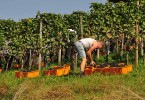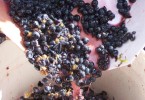Barrique Grappa, characteristics and production
Perfect for meditation, to taste at the end of the meal or to relax at the end of a stressful day on a comfortable armchair. A wrapping taste for all the senses, a unique and warm aroma, rich in perfumes that make it perfect to sip in a cold winter evening, but also in special occasions given its delicacy and elegance, that stands out in the palate. We are talking about the Queen of Grappa: Barrique Grappa.
Ageing or barrique?
Pay attention to not confuse barrique grappa with other grappa that are generically labelled as aged. The Italian law foresees, in fact, that the word “aged” used for grappa that has rest at least a year in barrels of any size and type of wood. The word barrique, instead, is more selective and can be used only for types of grappa aged in wooden barrels for at least 12 months, and at least half of them spend in “barriques” small barrels of not treated barrels, generally of durmast, but also ash or cherry wood with a load of around 225 litres.
Refining in barrique
Barrique grappa needs of rest, in durmast, ash or cherry wood barrels, after the distillation of the pomace, made with a distiller (or alembic) without head and tail. Thus, we are not talking about young grappa but, what make them unique is the ageing process or, better, the refining in barrels.
Refining of grappa has a variable time, minimum of 12 months, that each distillery decide by itself and occurs in wooden barrels, not treated with chemical substances to avoid that they pollute and transfer their substances to the liquid inside it. The barrels are not even waterproof to allow the wood to breath and to the grappa to absorb unique aromas and perfumes given by the wood.
The Barrique
Barrique is a barrel, with French origins, as its name reveal, with a medium load of 225 litres, that can exceed until and no more than 228 litres. The strength of these barrels is their small size, due to the relation volume-contact surface created, that is better, than barrels of other size, to allow a greater oxygenation of the grappa contained that develop, in this way unique organoleptic and olfactory properties.
Well appreciated and used, barrique are made of durmast wood, medium ripening, that comes form French and middle European forests, but a great production is also possible in the U.S.A.. the best durmast woods derives from trees grown slowly in a forest characterized by a thick wood, thin porosity and a good elasticity, greater in the trunks that lived more than 120 years. Trunks, once sewed, are cut in strips that mature open air or in airy places before being treated for the creations of the barrels. French durmast, among the most quality wood, is traditionally used since a long period of time. It is collected in different regions as Allier, Aquitania, Borgogna and it is famous for its notes of vanilla. The wood, before being assembled in a barrel, is subjected to roasting: a technique that consists in the passage of a direct flame in the internal part of the barrel before it is assembled. Depending on the intensity of the flower and the duration of the process the roasting can be of different types that will affect the aromas that wood will develop on the liquid during the ageing: light, medium, over medium, intense.
Once treated, the wood is ready to be assembled in a barrel, the durmast is cut in tables and each barrels needs around 25-30 strips that are put together with metal elements.
Ageing process
The ageing period is variable but never below, as the low requires, than 12 moths. The period, that each distillery decide on its own according to the organoleptic properties that want to reach, influence the final result in terms of aromas and perfumes developed thanks to the grappa. Besides the duration of the refining period, also the wood porosity, its quality, the eventual barrel smoking (that give to the wood a smoked perfume) and the characteristics of the place where the barrels are kept, as the humidity degree and the temperature. Only grappa aged in wood for 18 months can have the name “Riserva”.
Barrique Grappa: aromas and flavours
This grappa that have the advantage to have spent some months in barrique reach warm and wrapping aromas. Barrique grappa tends to be velvety and well structured, and can have shades of tobacco, smoked, wood but also vanilla, coffee, chocolate, cloves or ash. They tend to be round and pleasant grappa, certainly refined. The colour can be transparent or vary towards straw yellow and amber. The perfumes are generally intense and wrapping, lasting in the nose.








